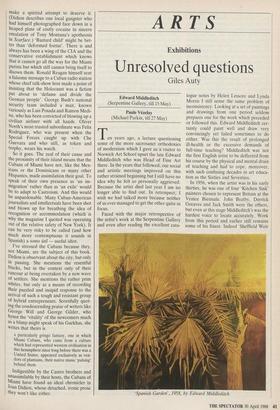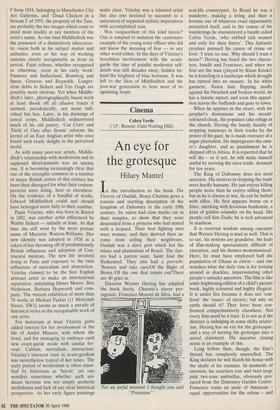ARTS
Exhibitions
Unresolved questions
Giles Auty
Edward Middleditch (Serpentine Gallery, till 15 May) Paule Vezelay (Michael Parkin, till 27 May)
Ten years ago, a lecture questioning some of the more sacrosanct orthodoxies of modernism which I gave as a visitor to Norwich Art School upset the late Edward Middleditch who was Head of Fine Art there. In the years that followed, our social and artistic meetings improved on this rather strained beginning but I still have no idea why he felt so personally aggrieved. Because the artist died last year I am no longer able to find out. In retrospect, I wish we had talked more because neither of us ever managed to get the other quite in focus.
Faced with the major retrospective of the artist's work at the Serpentine Gallery and even after reading the excellent cata- logue notes by Helen Lessore and Lynda Morris I still sense the same problem of inconsistency. Looking at a set of paintings and drawings from one period seldom prepares one for the work which preceded or followed this. Edward Middleditch cer- tainly could paint well and draw very convincingly yet failed sometimes to do either. Was this the result of prolonged ill-health or the excessive demands of full-time teaching? Middleditch was not the first English artist to be deflected from his course by the physical and mental drain of teaching and had to cope, moreover, with such confusing decades in art educa- tion as the Sixties and Seventies.
In 1956, when the artist was in his early thirties, he was one of four 'Kitchen Sink' painters chosen to represent Britain at the Venice Biennale. John Bratby, Derrick Greaves and Jack Smith were the others, but even at this stage Middleditch's was the hardest voice to locate accurately. Work from this period and earlier still remains some of his finest. Indeed 'Sheffield Weir 'Spanish Garden', 1958, by Edward Middleditch I' from 1954, belonging to Manchester City Art Galleries, and 'Dead Chicken in a Stream I' of 1955, the property of the Tate, are probably the two images which come to mind most readily at any mention of the artist's name. At one time Middleditch was the possessor of a distinctively idiosyncra- tic vision both in his subject matter and attitudes; even so his way of working remains clearly recognisable as from its period. Faint echoes, whether recognised or otherwise, recur in his early work: Pasmore and Sutherland, Bomberg and Spear, Greaves and Reynolds. Longer- term debts to Sickert and Van Gogh are possibly more obvious. Yet when Middle- ditch's later, photographically based work at least shook off all allusive traces it seemed, paradoxically, not more indi- vidual but less. Later, in his drawings of cereal crops, Middleditch rediscovered much of his old poetry. 'Cut Corn' and 'Field of Oats after Storm' relocate the kernel of an East Anglian artist who once found such ready delight in the perceived world.
As with many post-war artists, Middle- ditch's relationship with modernism and its supposed developments was an uneasy one. It is becoming increasingly clear that one of the strengths common to a number of major British artists of this century has been their disregard for what their contem- poraries were doing, here or elsewhere. On the evidence of a handful of works, Edward Middleditch could and should have belonged more fully to their number.
Paule Vezelay, who was born in Bristol in 1892, was another artist influenced by Walter Sicken — initially at least. At that time she still went by the more prosaic name of Marjorie Watson-Williams. Her new identity was adopted in 1926 as a token of her throwing off of predominantly British influences and adoption of Con- tinental mentors. The new life involved living in Paris and exposure to the twin influences of surrealism and abstraction. Vezelay claimed to be the first English abstract artist to make an international reputation, antedating Henry Moore, Ben Nicholson, Barbara Hepworth and com- pany. The nresent exhibition of more than 70 works at Michael Parkin (11 Motcomb Street, SW1) seems as much a parade of historical styles as the recognisable work of one artist.
For historians at least Vezelay gains added interest for her involvement in the life of Andre Masson, with whom she lived, and for managing to embrace each new avant-garde mode with similar fer- vour. Cubism, surrealism, abstraction; Vezelay's innocent trust in avant-gardism was nevertheless typical of her times. The early period of modernism is often classi- fied by historians as 'heroic' yet one wonders sometimes whether such soi- disant heroism was not simply aesthetic modishness and lack of any clear historical perspective. As her early figure paintings make clear, Vezelay was a talented artist but also one destined to succumb to a succession of supposed stylistic imperatives with accomplished ease.
Was vanguardism of this kind heroic? One is tempted to summon the cautionary example of the young army officer who did not know the meaning of fear — or any other word either. In the days of Vezelay's breathless involvement with the avant- garde the time of painful modernist self- doubt was still decades away, hidden be- hind the brightest of blue horizons. It was left to the likes of Middleditch and the post-war generation to bear most of its agonising brunt.



























































 Previous page
Previous page